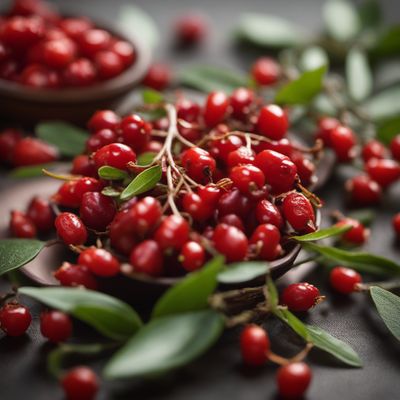
Ingredient
Wolfberries
The Superfood Berry
Wolfberries are small, bright red berries with a slightly sweet and tangy flavor. They have a chewy texture and are often consumed dried. These nutrient-dense berries are commonly used in traditional Chinese medicine and are believed to promote overall well-being.
Origins and history
Wolfberries have a long history in traditional Chinese medicine and have been used for centuries to improve vitality and longevity. They are native to China and are still primarily cultivated in the Ningxia region. Wolfberries gained popularity in the Western world in recent years due to their numerous health benefits.
Nutritional information
Wolfberries are a nutritional powerhouse, rich in antioxidants, vitamins A and C, and essential minerals such as iron and zinc. They are also a good source of fiber and contain all eight essential amino acids.
Allergens
There are no known allergens associated with wolfberries.
How to select
When selecting wolfberries, look for plump, bright red berries that are free from mold or discoloration. Dried wolfberries should be soft and slightly chewy. Opt for organic or sustainably grown varieties for the best quality and flavor.
Storage recommendations
To extend their shelf life, store dried wolfberries in an airtight container in a cool, dark place. They can also be refrigerated for longer storage. Fresh wolfberries should be consumed within a few days of purchase.
How to produce
Wolfberries can be grown in a home garden, but they require a sunny location and well-drained soil. They can also be purchased dried from specialty stores or online retailers.
Preparation tips
Wolfberries can be enjoyed as a snack on their own, added to trail mixes, or used in smoothies, teas, and baked goods. They can also be rehydrated by soaking them in water or juice before use.
Substitutions
Cranberries or raisins can be used as substitutes for wolfberries, although they have slightly different flavors and textures. N/A
Culinary uses
Wolfberries are commonly used in traditional Chinese cuisine, both in sweet and savory dishes. They are often added to soups, stews, rice dishes, and desserts. They are also popular in Western countries as a superfood ingredient in smoothies, granola bars, and energy balls.
Availability
Wolfberries are primarily cultivated in the Ningxia region of China. They are also grown in other parts of Asia, as well as in North and South America.
More ingredients from this category
Recipes using Wolfberries

Taiwanese-style Chicken Soup
Savory and Nourishing Taiwanese Chicken Soup

Heusuppe with a Malaysian Chinese Twist
Malaysian Chinese Herbal Soup with a European Touch

Snow Fungus and Red Dates Soup
Nourishing Winter Elixir: Snow Fungus and Red Dates Soup

Chinese Buddhist Style Nutty Pancakes
Zen Pancakes: A Nutty Delight from the East

Haipai-style Ginseng Chicken Soup
Savory Ginseng Infusion: Haipai-style Ginseng Chicken Soup

Sishen Soup with Nourishing Herbs
Healing Elixir: Sishen Soup to Nourish Your Body and Soul

Shaanxi Almond Cakes
Nutty Delights: Shaanxi Almond Cakes
